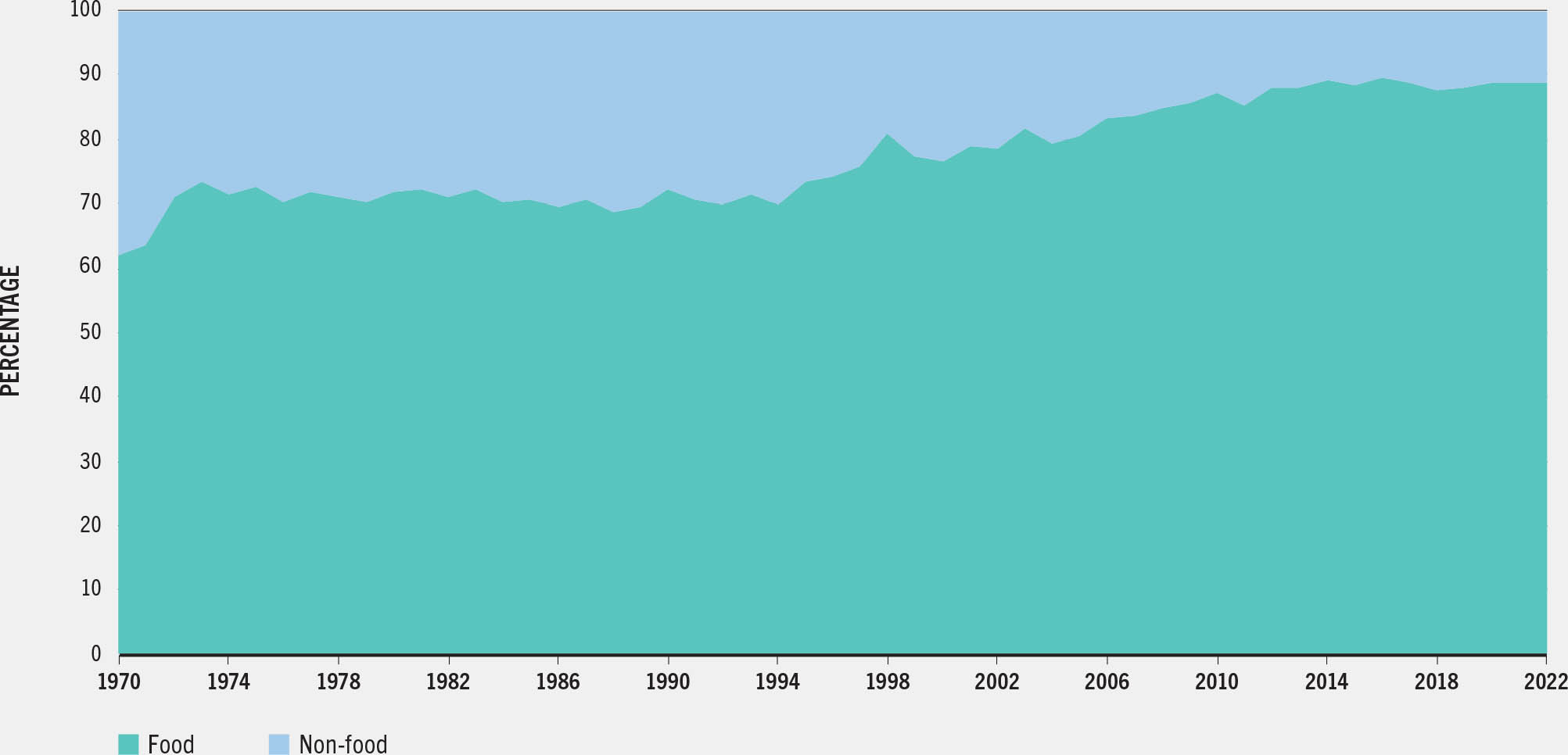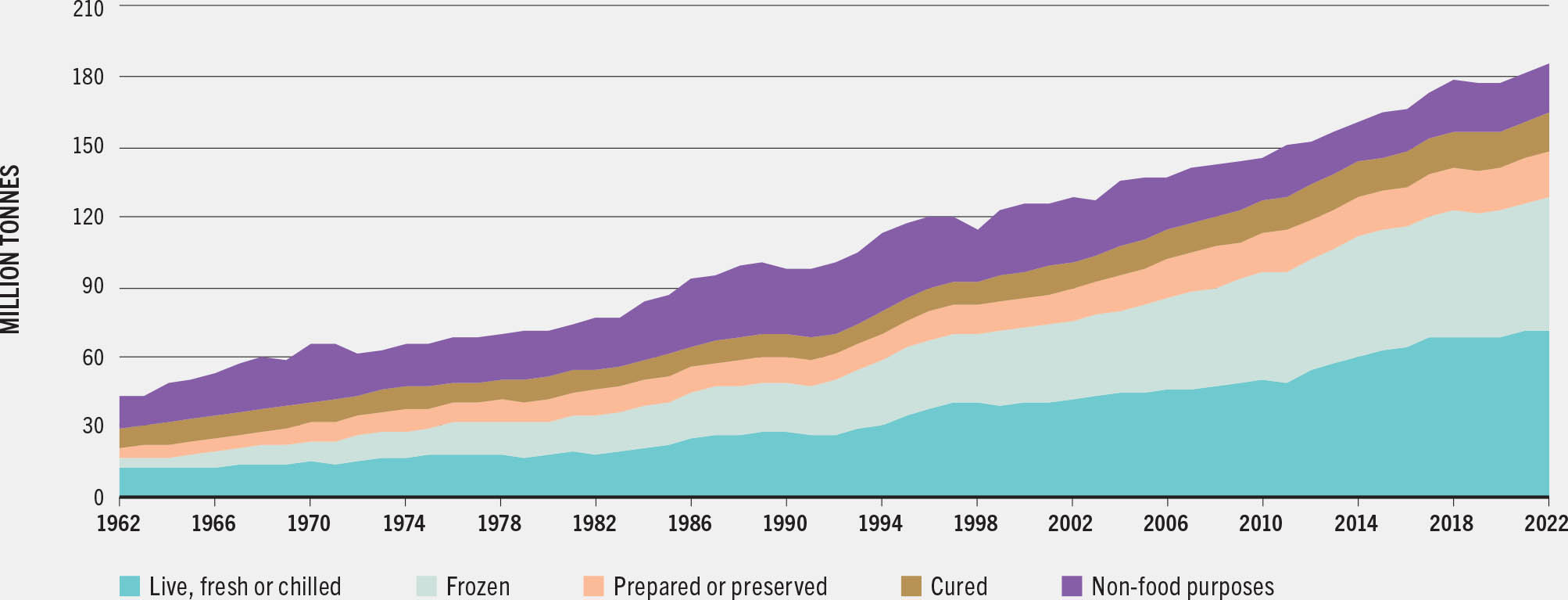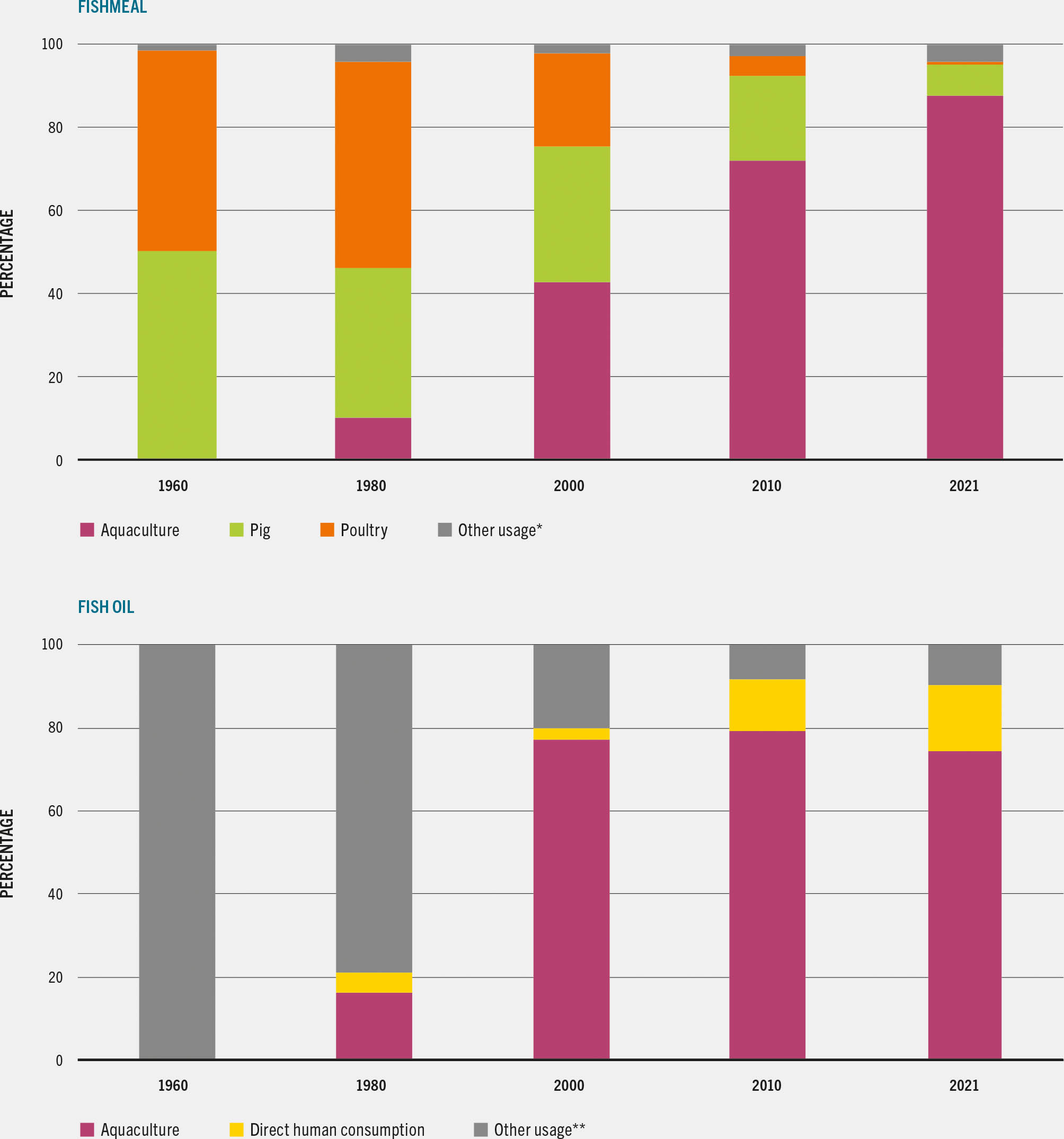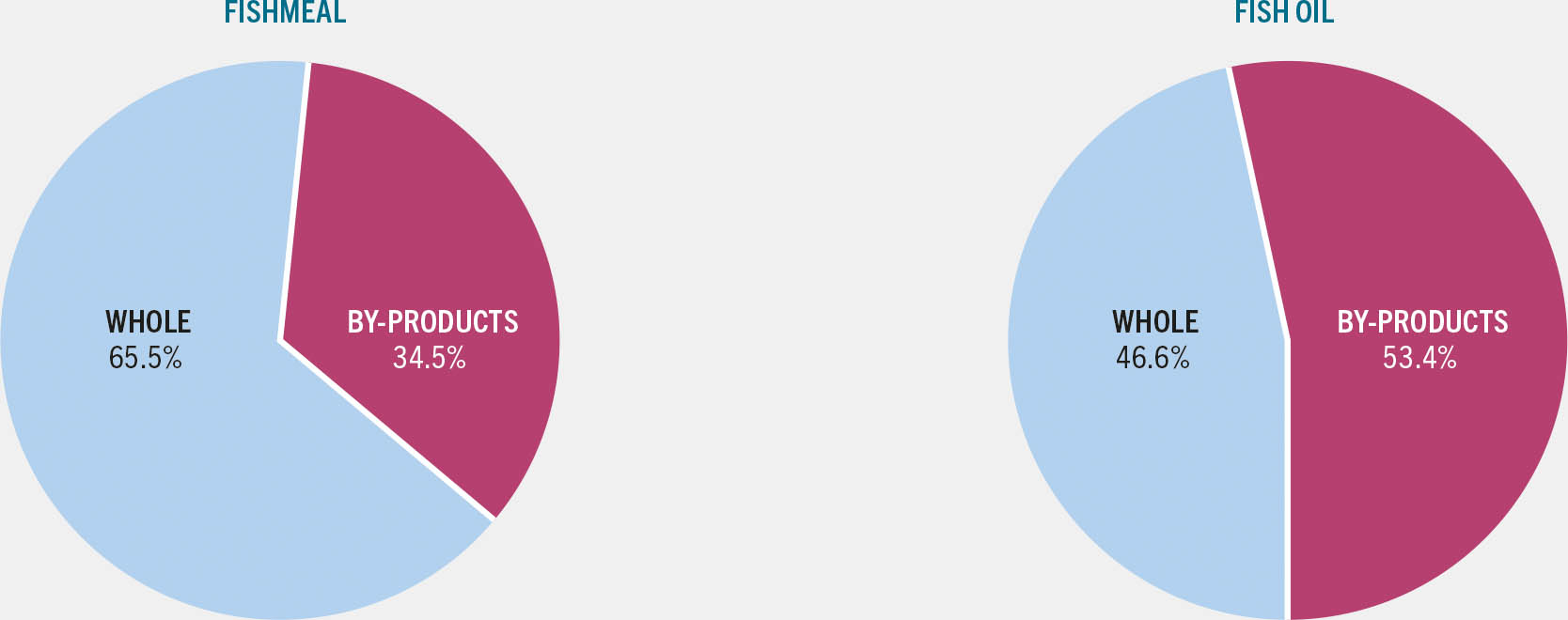Recent trends
Of the 185.4 million tonnes (live weight equivalent) of aquatic animals harvested globally in 2022, about 89 percent (164.6 million tonnes) was used for direct human consumption. The remaining 11 percent (20.8 million tonnes) was destined for non-food purposes, of which about 83 percent (17 million tonnes) was reduced to fishmeal and fish oil, while the rest (about 4 million tonnes) was largely utilized as ornamental fish, in aquaculture (e.g. as fry, fingerlings or small adults for ongrowing), as bait, in pharmaceutical applications, for pet food, or as raw material for direct feeding in aquaculture and for the raising of livestock and fur animals.
With some fluctuations, the proportion of production used for direct human consumption has increased significantly over the last decades, from 62 percent in 1970 to 89 percent in 2022 (Figure 32). The more notable growth since the mid-1990s was also due to a decrease in the catches of species targeted for reduction to fishmeal (see Products: fishmeal and fish oil, p. 68).
FIGURE 32SHARE OF UTILIZATION OF WORLD FISHERIES AND AQUACULTURE PRODUCTION OF AQUATIC ANIMALS BY FOOD AND NON-FOOD USE BY VOLUME

SOURCE: Preliminary data. Final data available here: FAO. (forthcoming). Fishery and Aquaculture Statistics – Yearbook 2022. FAO Yearbook of Fishery and Aquaculture Statistics. Rome. https://www.fao.org/fishery/en/statistics/yearbook
In 2022, of the 165 million tonnes destined for human consumption, live, fresh or chilled accounted for about 43 percent. This continues to represent the preferred and most high-priced form of aquatic food products, followed by frozen (35 percent), prepared and preserved (12 percent) and curedn (10 percent) (Figure 33). Freezing is the main method of preserving aquatic foods, accounting for 62 percent of the 93 million tonnes of processed aquatic animal production for human consumption (i.e. excluding live, fresh or chilled).
FIGURE 33UTILIZATION OF WORLD FISHERIES AND AQUACULTURE PRODUCTION OF AQUATIC ANIMALS, 1962–2022

SOURCE: Preliminary data. Final data available here: FAO. (forthcoming). Fishery and Aquaculture Statistics – Yearbook 2022. FAO Yearbook of Fishery and Aquaculture Statistics. Rome. https://www.fao.org/fishery/en/statistics/yearbook
Significant differences exist in the utilization and processing methods across continents, regions and countries, and even within countries. Preservation and processing may vary due to differences between species related to their characteristics, composition, size and shape. Aquatic species can be prepared using a wide range of methods, from manual to fully automated. An industrialized fishery often has different processing requirements from a small-scale artisanal fishery. Products can be packaged and commercialized in a wide variety of ways depending on the location, scale of operation, country’s infrastructure and market demand.
Overall, in high-income countries, aquatic foods are more processed than in other countries, with an increasing share of high-value-added products, such as ready-to-eat meals. In 2022, over 55 percent of the aquatic animal production destined for human consumption in high-income countries was in frozen form, 26 percent in prepared and preserved form, and 13 percent in cured form. In many countries, processing of aquatic products has been evolving from traditional methods to more advanced value-adding processes, depending on the commodity and market value.
In 2022, about 31 percent of the aquatic food production of upper- and lower-middle-income countries was utilized in frozen form, 9 percent each in canned and cured forms, and over 50 percent in live, fresh or chilled form. In contrast, for low-income countries, only 7 percent was frozen, about 20 percent cured and about 70 percent live, fresh or chilled.
Approximately two-thirds of the fisheries and aquaculture production used for human consumption is in frozen, prepared and preserved forms in Europe and Northern America. In Asia and Africa, the share of aquatic food production preserved by salting, smoking, fermentation or drying is higher than the world average. The share of fisheries and aquaculture production utilized for reduction into fishmeal and fish oil is highest in Latin America, followed by Asia and Europe.
A proportion of the production of aquatic animals for human consumption is commercialized in live form; this form is principally appreciated in East and Southeast Asia and has niche markets in other countries – mainly to supply Asian communities. Commercialization of live aquatic animals has continued to grow in recent years, thanks also to improved logistics and technological developments. Yet, marketing and transportation can be challenging, as they are often subject to stringent sanitary regulations, quality standards and animal welfare requirements (notably in Europe and Northern America).
Interest in the production and utilization of algae (seaweed and micro-algae) has increased greatly in recent years beyond the traditional Asian producing countries. Algae contribute significantly to food and nutrition security, provide ecosystem services, and their production and processing offer significant employment opportunities for coastal communities, in particular for women and youth. They can be processed into food products, as well as food additives and supplements. They are also used by the non-food industry to extract thickening agents such as alginate, agar and carrageenan, as hydrocolloid products in nutraceuticals, pharmaceuticals and cosmetics, and as fertilizers, feed ingredients, biofuels and bioplastics.
In general, aquatic species are highly perishable and several chemical and biological changes take place immediately after harvest; this can result in spoilage and food safety risks if good handling and preservation practices are not applied at harvesting and all along the supply chain. These practices are based on temperature reduction (chilling and freezing), heat treatment (canning, boiling and smoking), reduction of available water (drying, salting and smoking) and changing of the storage environment (vacuum packaging, modified atmosphere packaging and refrigeration). Aquatic food products also require special facilities such as cold storage and refrigerated transport, and rapid delivery to consumers.
During the last few decades, major improvements in processing, refrigeration, ice production and use, freezing, storage and transportation have enabled extended shelf-life – while ensuring food safety, maintaining quality and nutritional attributes, and avoiding loss and waste – thus enabling distribution domestically and internationally over long distances. These improvements have also led to an increasing variety of products, with more efficient, effective and lucrative utilization of raw materials, and innovation in product diversification for human consumption as well as for production of fishmeal and fish oil and other purposes including through the utilization of by-products (see Products: fishmeal and fish oil, p. 68 and By-product utilization, p. 71).
Overall, the expansion in commercialization and human consumption of aquatic food products (see Apparent consumption of aquatic foods, p. 214, and Trade of aquatic products, p. 82) has been accompanied by a significant improvement in food quality and safety standards. In recent decades, the fisheries and aquaculture sectors have become more complex and dynamic, with developments driven by high demand from the retail industry, species diversification, outsourcing of processing, and stronger supply linkages between producers, processors and retailers. As supermarket chains and large retailers have expanded worldwide, their role as key players has increased, as they influence market access requirements and standards. To meet food safety and quality standards and ensure consumer protection, increasingly stringent hygiene and handling measures have been adopted at the national, regional and international levels, based on the Codex Code of Practice for Fish and Fishery Products (FAO and WHO, 2020) and its guidance to countries on practical aspects of implementing good hygiene practices and the Hazard Analysis Critical Control Point (HACCP)-based food safety management system. Nutritional attributes of aquatic foods can vary according to how they are processed and prepared. Heating the product (for sterilization, pasteurization, hot smoking or cooking) reduces the quantities of thermolabile nutrients, including many vitamins; on the other hand, the concentration of some nutrients can increase with heating, as water is removed.
Products: fishmeal and fish oil
Fishmeal is a protein-rich flour made by milling and drying fish or fish parts, while fish oil is obtained by pressing cooked fish and centrifuging the liquid extracted. Fishmeal and fish oil are considered among the most nutritious and most digestible ingredients for farmed fish, as well as the principal source of omega-3 long-chain polyunsaturated fatty acids (eicosapentaenoic acid [EPA] and docosahexaenoic acid [DHA]) in animal diets. Regarding human consumption, fish oil is the major natural source of EPA and DHA, which perform a wide range of critical functions for human health.
Fishmeal and fish oil can be produced from whole fish, fish trimmings or other fish by-products. The species used whole are mainly small pelagic fish, such as Peruvian anchoveta (accounting for the greatest proportion), menhaden, blue whiting, capelin, sardine, mackerel and herring. The amount of fishmeal and fish oil production fluctuates yearly according to changes in the catches of those species, in particular anchoveta, whose catchability can be affected by the El Niño Southern Oscillation and by the adopted management practices (see Impacts of El Niño on marine fisheries and aquaculture, p. 202). Over time, the adoption of good management practices and certification schemes has increased the volume of species fished and recognized as sourced responsibly for reduction to fishmeal, thus decreasing the volumes of unsustainable catches for those species.
The volume of world capture fisheries production processed into fishmeal and fish oil has declined during the last few decades. From a peak of over 30 million tonnes in 1994, representing about 35 percent of marine capture fisheries, it declined over the years to less than 14 million tonnes in 2014, then rose to about 18 million tonnes in 2018 due to increased catches of Peruvian anchoveta, before going back to previous trends, with more than 17 million tonnes utilized in 2022. This corresponds to about 22 percent of capture fisheries in marine waters in 2022. At the same time, a growing share of fishmeal and fish oil is produced from fish by-products of the processing industry, thus reducing waste and improving resource valorization. According to the estimates of the Marine Ingredients Organisation (IFFO), in 2022, 34 percent of the global production of fishmeal and 53 percent of the total production of fish oil were obtained from by-products; Figure 34). This utilization of by-products has helped to keep the overall amount of fishmeal and fish oil reasonably stable since the mid-2000s at, respectively, around 5 million tonnes and 1 million tonnes in product weight, despite the decline in the share obtained from whole fish. It is worth noting that fishmeal from by-products has a different nutritional value, being lower in protein but richer in minerals compared with fishmeal obtained from whole fish.
FIGURE 34UTILIZATION OF FISHMEAL AND FISH OIL IN SELECTED YEARS

SOURCE: IFFO estimates.
The overall stable production has been coupled with a surging demand driven by a fast-growing aquaculture industry, as well as by pig and poultry farming, and the pet food and pharmaceutical industries. According to the estimates of IFFO, in 2021, over 87 percent of fishmeal was used in aquaculture, over 7 percent in pig farming, 4 percent for other uses (mainly pet food) and 1 percent for poultry. In the same year, about 74 percent of fish oil was destined for aquaculture, 16 percent for human consumption and 10 percent for other uses (including pet food and biofuel) (Figure 35).
FIGURE 35SHARE OF RAW MATERIAL UTILIZED FOR REDUCTION INTO FISHMEAL AND FISH OIL, 2022

The increasing demand for fishmeal and fish oil has led to an increase in their prices, with an impact on their utilization. Their inclusion rates in compound feeds for aquaculture have shown a clear downward trend, largely as a result of diversified protein sources and improved feeding efficiency to respond to supply and price variations and increasing demand from the aquafeed industry. Fishmeal and fish oil are increasingly used selectively at specific stages of production, such as for hatchery, broodstock and finishing diets, and their incorporation in grower diets is decreasing. For example, their share in grower diets for farmed Atlantic salmon is now often less than 10 percent and there has been a continued reduction across all categories of species. Moreover, most of the main aquaculture species produced do not use only fishmeal or fish oil as a source of protein, but also ingredients such as other animal by-products and plant-based proteins.
Increasing demand and the profitability of the sector have led to pressure to find additional or alternative sources of aquafeeds. Although most fishmeal and fish oil produced from whole fish originate from well-managed fisheries, there is concern regarding the sustainability of certain fisheries in some countries where fishmeal production is increasing significantly. This is the case of some West African countries where increasing amounts of catch are reduced into fishmeal for export purposes, competing with their traditional use for domestic human consumption. This not only increases the pressure on fishery resources in the absence of proper resource management, but it negatively impacts food security and livelihoods. In these areas, it is essential to improve governance and fisheries management, while prioritizing the utilization of aquatic species for human consumption and food security (Thiao and Bunting, 2022).
Overall, with no major increases in raw material expected to come from wild fisheries, any increase in fishmeal and fish oil production will need to come from fish by-products and other sources. Research has recently focused on finding alternative sources of polyunsaturated fatty acids. These include stocks of marine zooplankton, such as Antarctic krill (Euphausia superba) and the copepod Calanus finmarchicus, although concerns remain over the impacts on marine food webs. Krill oil in particular is marketed as a human nutrient supplement, while krill meal is finding a niche in the production of certain aquafeeds. However, krill processing presents practical challenges regarding reduction of its fluoride content and the high cost of zooplankton products means they are not included as a bulk oil or protein ingredient in fish feed. Other sources such as insect and bacterial meals offer good potential as protein feed inputs to aquafeeds (Glencross et al., 2024). Fish silage, a rich protein hydrolysate that contains high amounts of essential amino acids, is also increasingly used as a feed additive, for example, in aquaculture and the pet food industry (see Innovative aquaculture systems and aquafeed solutions, p. 131).
By-product utilization
The increase in global fisheries and aquaculture production poses a challenge for the aquatic food processing industry. Fish processing generates large quantities of by-products such as heads, skins, bones, scales and viscera, constituting 30 to 70 percent of the whole fish, depending on the species and type of processing (Peñarubia et al., 2023). A tilapia fillet typically represents 30 percent of the fish, leaving the rest unused for human consumption (see Aquatic foods: an untapped potential for healthy diets, p. 191). It is estimated that 50 to 70 percent of whole tuna is discarded in tuna canning (Honrado et al., 2023), while the by-products from shrimp processing make up 40 to 60 percent of the whole shrimp (Abuzar et al., 2023).
The by-products of aquatic food processing were traditionally considered of low value and discarded as waste. Inappropriate waste management causes environmental pollution leading to breeding grounds for insects and vermin, posing significant public health risks. Accordingly, waste management is increasingly subject to strict regulations for environmental reasons, and it represents a growing cost burden for the aquatic food industry. At the same time, by-products can represent an opportunity for industry. Improving their utilization is important for ecological, social and economic reasons and to safeguard consumer health and food security (see Box 17, p. 140).
Aquatic by-products can be converted into food products for human consumption. Those particularly rich in micronutrients and bioactive ingredients can be used as valuable raw materials for low-cost nutritious foods or high-value products used by the food, pharmaceutical, cosmetic and material industries. The conversion of these by-products into value-added products can enhance human nutrition and health, mitigate environmental pollution, and provide livelihoods and economic returns. This way, it can help reduce the pressure on living aquatic resources and foster their sustainability.
By-products containing heads, frames and belly flaps, and parts of the viscera like liver and roe are good sources of high-quality proteins, lipids with long-chain omega-3 fatty acids, micronutrients like vitamins A, D and B12, and minerals such as iron, zinc, selenium and iodine. Their minced meat and mechanically separated meat can be used as raw materials to produce surimi, patties, nuggets and sausages. Heads and frames can be minced and processed into powder (Abbey et al., 2017) to be used as either condiments or flour, producing a healthy alternative (Monteiro et al., 2014). Gelatin can also be extracted and used as a food ingredient for edible films or coatings; it can also replace mammal-based gelatin – which is usually pork-based – providing a valid alternative for some religious groups.
Aquatic by-products are a source of high-value biocompounds containing collagen, peptides, chitin, polyunsaturated fatty acids, enzymes and minerals, suitable for biotechnological or pharmaceutical applications. Collagen and gelatin can be extracted from skin, scales and bones. Collagen can be used to treat burns for wound healing and skin regeneration (Lima Verde et al., 2021). By-products can be converted into protein hydrolysate with beneficial functional properties and potential for applications in health care and pharmaceutical products (Ryu, Shin and Kim, 2021) and used as a valuable low-cost natural antioxidant for several food and pharmaceutical applications (Sierra et al., 2021). Chitin, which is present in almost all crustaceans, has been used to produce bioactive products for pharmaceutical and food applications.
Fish by-products deteriorate very fast, especially when they contain viscera. They should be preserved or processed as soon as possible. In the absence of cold rooms, they can be converted into feed, fertilizer or fish silage rich in hydrolysed protein and essential amino acids. Biodiesel made from fish oil can meet the specifications for biodiesel, for example, low ash content, flash point and density (Patchimpet et al., 2020). Because of its excellent biocompatibility and biodegradability, fish skin has been used in food and pharmaceutical applications, and in the production of clothing and leather products (Yoshida et al., 2016).
These technologies using fish by-products are also used to process low-value and bycatch aquatic resources into value-added products, reducing environmental pollution and improving human nutrition, income and livelihoods.
Aquatic food loss and waste
Food loss and waste (FLW) in aquatic value chains remains an important focus for FAO. In terms of quantity and quality, FLW is driven by inefficiencies in value chains. Many developing countries – especially the least developed economies – still lack adequate infrastructure, services and know-how for adequate onboard and onshore handling and preservation. The inability to access electricity, potable water, roads, ice, cold storage and refrigerated transport are contributing factors. Food loss and waste equates to a waste of time, energy and money, producing a detrimental effect on the well-being of fishers, processors, traders and consumers.
The Code of Conduct for Responsible Fisheries, the Voluntary Guidelines for Securing Small-Scale Fisheries in the Context of Food Security and Poverty Eradication and the FAO Fisheries Blue Transformation Roadmap all flag food loss and waste as a key issue. Reducing FLW ultimately helps achieve FAO’s high-level policy objectives of better production, better nutrition, a better environment and a better life,o and SDG Target 12.3, which focuses on responsible consumption and production and halving food wastage by 2030. The FAO Blue Transformation Roadmap (FAO, 2022a) promotes access to safe and nutritious aquatic food for all, in particular for vulnerable populations, and the reduction of FLW using diverse practices and processes.
In 2011, FAO estimated that up to 35 percent of global fisheries and aquaculture production is either lost or wasted every year (FAO, 2011b). Decision-making is hampered, particularly at the national level, by the lack of current data and information that could be used to target and design FLW interventions.
Bearing in mind that data are key to informed decision-making, FAO has adopted methodologies to assess, measure and understand fish loss and waste and is developing a Food Loss Index methodology,p which will be used to standardize the way in which quantitative data on fish loss will be collected globally. Knowledge tools such as e-learning coursesq in fish loss and waste are available alongside a comprehensive websiter which provides information on all aspects of FLW in aquatic value chains. Initiatives are informed by renewable energy work (Puri et al., 2023) around cold chains, improved onboard handling (Ward, 2022), best practices and guidance on gender in relation to food losses (FAO, 2018a).
The Voluntary Code of Conduct for Food Loss and Waste Reductions provides internationally recognized guiding principles and standards for responsible practices for food loss and waste reduction. It acts as a framework for strategies, policies, institutions, legislation and programmes on FLW reduction and provides guidance to gauge the effectiveness of solutions, promoting joint action, the harmonization of approaches and the assessment of progress. This code of conduct is applied in the fisheries context as part of the adoption of a multidimensional and multistakeholder approach to FLW reduction with a focus on seven key entry points: policy; social and gender equity; services and infrastructure; markets; technology; skills and knowledge; and the regulatory environment. To date, strategies for FLW reduction in fisheries value chains have been developed with partners in Colombia, Sri Lanka, Togo and the United Republic of Tanzaniat (see Box 33, p. 172 and Multidimensional solutions to food loss and waste, p. 183).
- n Cured means dried, salted, in brine, fermented, smoked, etc.
- o For details, please see: https://www.fao.org/strategic-framework/en
- p See: https://www.fao.org/platform-food-loss-waste/food-loss/food-loss-measurement/en
- q See: https://elearning.fao.org/course/view.php?id=567 and https://elearning.fao.org/course/view.php?id=1031
- r See: https://www.fao.org/flw-in-fish-value-chains/en/
- s See: https://www.fao.org/3/nf393en/nf393en.pdf
- t See: https://www.fao.org/flw-in-fish-value-chains/projects/en/

